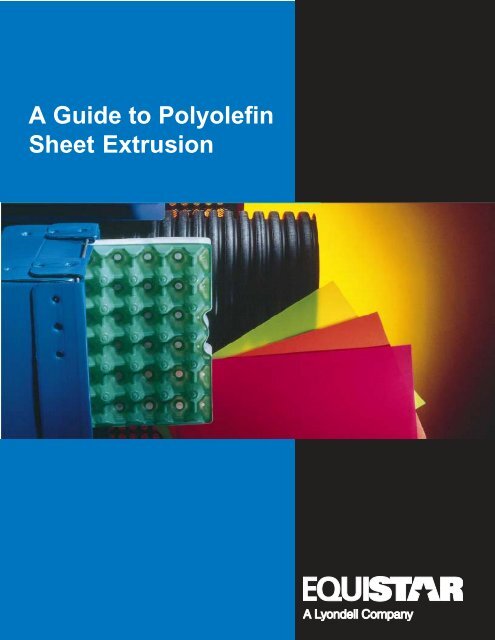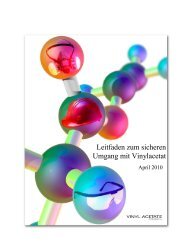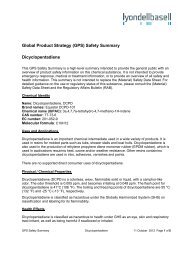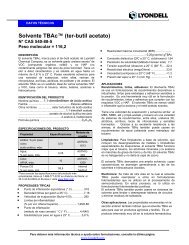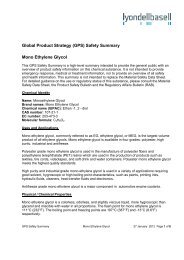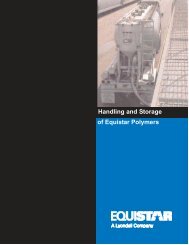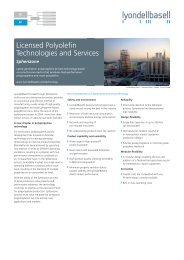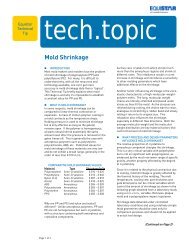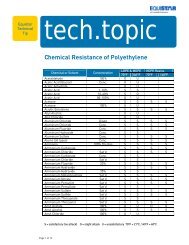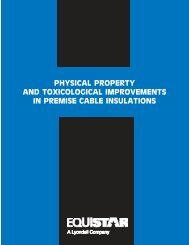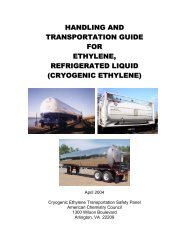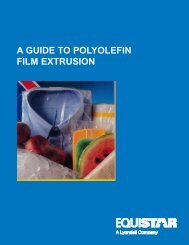A Guide to Polyolefin Sheet Extrusion - LyondellBasell
A Guide to Polyolefin Sheet Extrusion - LyondellBasell
A Guide to Polyolefin Sheet Extrusion - LyondellBasell
Create successful ePaper yourself
Turn your PDF publications into a flip-book with our unique Google optimized e-Paper software.
A <strong>Guide</strong> <strong>to</strong> <strong>Polyolefin</strong><br />
<strong>Sheet</strong> <strong>Extrusion</strong>
Equistar is one of the largest producers of ethylene, propylene and<br />
polyethylene in the world <strong>to</strong>day. One of the largest, yet we pay attention<br />
<strong>to</strong> even the smallest needs of our cus<strong>to</strong>mers.<br />
We’re a leading producer of polypropylene, oxygenated chemicals,<br />
performance polymers, and resins and compounds for wire and cable.<br />
We’re an industry leader with an unwavering commitment <strong>to</strong> being<br />
the premier petrochemicals and polymers company.<br />
Our commitment starts with each of our more than 5,000 employees.<br />
It stretches out from our headquarters in Hous<strong>to</strong>n across 16 manufacturing<br />
facilities along the U.S. Gulf Coast and in the Midwest. It<br />
continues through our 1,400-mile ethylene/propylene distribution<br />
system that spans the Gulf Coast.<br />
We are the product of many minds coming <strong>to</strong>gether with the single<br />
focus of providing the right product for every cus<strong>to</strong>mer. That’s what<br />
drives us <strong>to</strong> maintain an extended product line, enhanced operating<br />
efficiencies, greater geographic diversity and strong research and<br />
development capabilities. That’s what drives us <strong>to</strong> provide the<br />
resources that help us lead <strong>to</strong>day and rise <strong>to</strong> the challenges of a<br />
changing industry <strong>to</strong>morrow.<br />
One Source. More Resourceful.
A <strong>Guide</strong> <strong>to</strong> <strong>Polyolefin</strong> <strong>Sheet</strong> <strong>Extrusion</strong><br />
Table of Contents<br />
Introduction ...................................................................................................2<br />
The Extruder ..................................................................................................2<br />
The Screw and Barrel<br />
The Compression Ratio<br />
The Length/Diameter Ratio<br />
The Feed Zone<br />
The Compression Zone<br />
The Metering Zone<br />
The Head Zone ..............................................................................................5<br />
Static Mixer<br />
Melt Pump<br />
Breaker Plate<br />
<strong>Sheet</strong> Die .......................................................................................................6<br />
Manifold Section<br />
Pre-Land Section<br />
Secondary Manifold<br />
Lip-Land Section<br />
Deckles<br />
<strong>Sheet</strong> Cooling ................................................................................................8<br />
Polished Roll Stack<br />
Cooling Conveyor<br />
Pull Roll<br />
Auxiliary Equipment .......................................................................................9<br />
Continuous Thickness Measurement<br />
Static Elimina<strong>to</strong>r<br />
Corona Treater<br />
Resin Selection.............................................................................................10<br />
Safety ..........................................................................................................10<br />
Equipment<br />
Warning Signs<br />
Procedures<br />
Start-Up Procedures .....................................................................................11<br />
Set-Up and Calibration<br />
Troubleshooting <strong>Guide</strong>.................................................................................12<br />
Metric Conversion <strong>Guide</strong> .............................................................................13<br />
1
2<br />
A <strong>Guide</strong> <strong>to</strong> <strong>Polyolefin</strong> <strong>Sheet</strong> <strong>Extrusion</strong><br />
Introduction<br />
This manual describes the extrusion<br />
process and identifies the components<br />
of a single-layer sheet extruder.<br />
The manual offers guidelines<br />
for resin selection, processing and<br />
troubleshooting polyethylene and<br />
polypropylene. This manual is not<br />
intended <strong>to</strong> replace OEM standard<br />
procedures, guidelines or formal<br />
training.<br />
The information in this manual is<br />
based on practical experience of<br />
Equistar’s technical service engineers<br />
and a collection of abstracts from<br />
numerous publications believed <strong>to</strong><br />
be true.<br />
Figure 1. Schematic Diagram of a<br />
<strong>Sheet</strong> Extruder Line (Courtesy of<br />
Welex Incorporated)<br />
1 – The Drive Mo<strong>to</strong>r<br />
2 – The Gear Drive<br />
3 – High Efficiency Gear<br />
4 – Thrust Bearing<br />
5 – Feed Opening<br />
6 – Heating Elements<br />
7 – Cooling<br />
8 – High Performance Screw<br />
9 – Piping & Wiring<br />
10 – Fully Insulated Guard<br />
11 – Base<br />
12 – Venting<br />
13 – Screen Changer<br />
14 – Gear Pump<br />
15 – Static Mixer<br />
16 – Die<br />
The extrusion process is a continuous<br />
operation of melting and<br />
conveying a polymer in a heated<br />
screw-and-barrel assembly. The<br />
homogenous melt is forced <strong>to</strong> flow<br />
through a screen pack, then a sheet<br />
die from which it exits in the<br />
desired width and thickness. The<br />
die discharge, or extrudate, is<br />
wound through a three-chill-roll<br />
stack for cooling. The solid sheet is<br />
then cooled further on a cooling<br />
conveyor while the edges are<br />
trimmed <strong>to</strong> final sheet width. The<br />
sheet is either rolled or sheared for<br />
later use.<br />
16 15 14 13<br />
11<br />
The Extruder<br />
The Screw and Barrel<br />
An extruder screw is a long steel<br />
shaft with increasing root diameter<br />
and helical flights of constant pitch<br />
wrapped around it. A polyethylene<br />
and polypropylene screw extruder<br />
has typically a 3:1 compression ratio<br />
and a minimum 24:1 length-overdiameter<br />
(L/D). Such a screw may<br />
be a single-stage or two-stage<br />
screw depending on the desired<br />
production output and mixing<br />
requirements. The extruder barrel is<br />
a hollow cylinder that houses the<br />
screw. The clearance between the<br />
screw flights and the inside wall of<br />
the barrel is small, 0.005 inch, but<br />
constant throughout the length of<br />
the barrel. The barrel has an opening<br />
immediately above the first<br />
flight of the screw in the feed zone<br />
that serves as the inlet <strong>to</strong> free-flowing<br />
pellets from a hopper above.<br />
12<br />
9<br />
7<br />
The Compression Ratio<br />
The volume of the first flight in the<br />
feed section <strong>to</strong> the last flight in the<br />
metering section is known as the<br />
compression ratio (CR). A typical<br />
polyethylene screw has a compression<br />
ratio of 3:1. A higher CR<br />
causes excess shearing and resin<br />
degradation. A lower CR provides<br />
inadequate shear and poor intermixing<br />
of the molten polymer.<br />
The Length/Diameter<br />
Ratio<br />
Simply known as L/D, this ratio is<br />
desired at 24:1 or greater. This<br />
means the screw length is 24 times<br />
the diameter of the screw. These<br />
dimensions ensure adequate residence<br />
time for the polymer <strong>to</strong> melt<br />
and mix.<br />
The extruder screw is designed with<br />
three main zones or sections: feed,<br />
compression and metering sections.<br />
6<br />
8<br />
1<br />
10<br />
Figure 2. <strong>Extrusion</strong> screw (Courtesy of Spirex)<br />
The Feed Zone<br />
The feed zone of the screw has a<br />
constant pitch and channel depth.<br />
The feed zone heats and softens<br />
the plastic pellets by conduction<br />
from the heaters, which are placed<br />
around the barrel and, <strong>to</strong> a lesser<br />
5<br />
3<br />
2<br />
4<br />
degree, from friction. The feed zone<br />
has the deepest channels of any of<br />
the screw sections. The feed zone is<br />
often operated at a temperature<br />
cooler than the rest of the extruder<br />
by circulating water inside the screw<br />
shaft <strong>to</strong> maximize the difference<br />
between its temperature and that<br />
of the barrel. The temperature gradient<br />
between the barrel and screw<br />
surfaces allows the polymer <strong>to</strong> stick<br />
<strong>to</strong> the barrel surface, slip on the<br />
screw surface and maximize its<br />
forward progress as the screw<br />
rotates. Should the screw surface<br />
temperature approach that of the<br />
barrel, then the melt sticks <strong>to</strong> the<br />
screw and rides around the screw<br />
shaft and becomes stationary. This<br />
condition is known as “bridging”<br />
and results in a low output and<br />
ultimately loss of output.<br />
Sometimes grooves in the barrel<br />
help increase the feeding rate.<br />
3
4<br />
The Compression Zone<br />
The compression zone, also known<br />
as the transition zone, has a cone<br />
shaped root and a reduced channel<br />
depth. This section compresses<br />
the soft pellets in<strong>to</strong> a melt and<br />
squeezes out entrapped air. As the<br />
melt undergoes compression, additional<br />
heat is generated from the<br />
high friction between the polymer<br />
on one side and the flight and<br />
barrel surfaces on the other. This<br />
heat is known as frictional heat and<br />
is combined with external heat from<br />
electrical heaters. The compression<br />
zone is commonly about 50 percent<br />
of the screw length. The compression<br />
zone may be either tapered or<br />
step design.<br />
The Metering Zone<br />
The metering zone of the screw<br />
begins at the end of the compression<br />
section and ends at the screw<br />
tip. The metering zone has a constant<br />
cross section and smaller<br />
channel depth than either the feed<br />
and compression sections. Because<br />
of these dimensions, the polymer in<br />
the metering zone is subjected <strong>to</strong><br />
intensive shear and mixing, which<br />
are essential steps <strong>to</strong> homogenize<br />
the polymer physically and thermally.<br />
The temperature gradient within<br />
the polymer can vary between 10°F<br />
and 50°F from the surface of the<br />
screw <strong>to</strong> the surface of the barrel.<br />
A uniform polymer temperature is<br />
critical <strong>to</strong> avoid delaminating, warping<br />
and other imperfections in the<br />
finished product. The metering<br />
section may have a mixing device<br />
such as a Maddock mixer or mixing<br />
pins (Figures 3 and 4) <strong>to</strong> provide<br />
additional mixing of the polymer.<br />
Figure 3. Maddock mixer<br />
ENTRANCE FLUTE WIPING LAND<br />
MELT FLUTE MIXING LAND<br />
Figure 4. Mixing pins<br />
MIXING LANDS<br />
OUTLET FLUTE<br />
WIPING LANDS<br />
ROTATION
Head Zone<br />
The head zone assembly of an<br />
extruder system is positioned<br />
between the discharge end of the<br />
screw and barrel and the die<br />
entrance. The head zone assembly<br />
normally consists of one or a combination<br />
of several of the following:<br />
• A static mixer, such as a Kenics<br />
or Koch, that provides distributive<br />
mixing and promotes homogeneous<br />
temperature of the<br />
polymer (Figure 5).<br />
• A melt pump, often called a gear<br />
pump, a rotary-gear device<br />
intended <strong>to</strong> boost the system<br />
pressure and meter the polymer<br />
<strong>to</strong> the die inlet at a stable, surgefree<br />
rate (Figure 6). The pump<br />
allows the extruder <strong>to</strong> operate as<br />
an efficient melting device independent<br />
of its pumping function.<br />
Figure 6. Melt pump<br />
(Courtesy of Welex Incorporated)<br />
• A breaker plate that holds<br />
the screen pack. A typical<br />
20/40/60/80-mesh screen pack is<br />
recommended for polyethylene<br />
and polypropylene processing.<br />
Higher gauge (finer mesh size)<br />
may be used <strong>to</strong> increase backpressure<br />
and mixing; however, it<br />
may limit extrusion output and<br />
raise melt temperature, causing<br />
degradation (Figure 7).<br />
Figure 5. Static mixing sections (Courtesy of Chemineer-Kenics)<br />
Figure 7. Breaker plate (Courtesy of Dynisco)<br />
5
6<br />
<strong>Sheet</strong> Die<br />
A sheet die serves <strong>to</strong> spread the<br />
molten polymer <strong>to</strong> a predetermined<br />
width and uniform thickness. A<br />
balanced die is essential for uniform<br />
sheet thickness. A typical polyethylene,<br />
monolayer, sheet die has<br />
a standard, coat hanger-type,<br />
manifold design. This die has a<br />
streamlined manifold with a<br />
teardrop-shape profile and chromeplated<br />
flow passage with a mirror<br />
finish. Such a die has an internal<br />
adjustable choker bar <strong>to</strong> distribute<br />
polymer flow uniformly across the<br />
full width of the die and a flexible<br />
upper lip and fixed lower lip for fine<br />
tuning of the final sheet thickness<br />
(Figures 8 and 9).<br />
To properly design a sheet die, a die<br />
manufacturer requires the following<br />
information:<br />
• Rheological data such as viscosity<br />
versus shear rate of the polymer<br />
(Figure 10).<br />
• Thickness range of final product.<br />
• <strong>Sheet</strong> width.<br />
• Throughput rate.<br />
Manifold Section<br />
The primary manifold is designed <strong>to</strong><br />
distribute the melt from the center<br />
<strong>to</strong> each end of the die at a uniform<br />
flow rate and pressure. The manifold<br />
cross section is usually teardrop<br />
or half-teardrop in shape, which<br />
allows for gradual transition from<br />
the manifold height <strong>to</strong> the pre-land<br />
section. The manifold cross-section<br />
area is usually reduced in a linear<br />
fashion from the center <strong>to</strong> the ends<br />
of the die, which ensures minimal<br />
polymer residence time and reduces<br />
the possibility of resin stagnation<br />
and degradation.<br />
Figure 8. Multiflow I – standard coat hanger-type die (Courtesy of EDI)<br />
LINEAR PRE-LAND<br />
PRIMARY MANIFOLD<br />
PRE-LAND<br />
SECONDARY MANIFOLD<br />
LIP LAND<br />
Figure 9. <strong>Sheet</strong> die with internal deckles (Courtesy of EDI)
Pre-Land Section<br />
The pre-land shape is linear and distributes<br />
the melt from the center <strong>to</strong><br />
the outside edge of the die.<br />
Secondary Manifold<br />
Any stress in the melt not relieved<br />
in the pre-land section is provided<br />
here before the melt exits the die.<br />
Lip-Land Section<br />
This section is designed for tuning<br />
pressure for a specific opening<br />
range allowing fine tuning of the<br />
final sheet thickness.<br />
Deckles<br />
Deckles produce a sheet narrower<br />
than the die width by blocking the<br />
extremities of the die lip, either<br />
externally or internally, with metal<br />
pieces called deckles. The deckles<br />
force the resin <strong>to</strong> exit the die from<br />
the unblocked, but narrower die<br />
width. Deckles may promote resin<br />
stagnation that leads <strong>to</strong> degradation<br />
of the polymer. Deckles should<br />
not reduce the width of the melt<br />
more than 25 percent.<br />
Figure 10. Viscosity vs. shear rate of Petrothene ® LB 8320<br />
CORRECTED VISCOSITY (poise)<br />
10 4<br />
10 3<br />
10 10 2<br />
CORRECTED SHEAR RATE (sec -1 )<br />
Viscosity as a function of shear-rate and temperature<br />
T = 170°C<br />
T = 190°C<br />
T = 210°C<br />
T = 230°C<br />
SHEAR RATE VISCOSITY, POISE<br />
1/sec 338.0°F 374.0°F 410.0°F 446.0°F<br />
1/sec 170.0°C 190.0°C 210.0°C 230.0°C<br />
1.585E+01 3.86E+04 — — —<br />
2.512E+01 3.00E+04 2.61E+04 2.30E+04 —<br />
3.981E+01 2.31E+04 2.02E+04 1.78E+04 1.59E+04<br />
6.310E+01 1.78E+04 1.56E+04 1.38E+04 1.23E+04<br />
1.000E+02 1.36E+04 1.19E+04 1.06E+04 9.48E+03<br />
1.585E+02 1.03E+04 9.12E+03 8.11E+03 7.27E+03<br />
2.512E+02 7.83E+03 6.93E+03 6.18E+03 5.56E+03<br />
3.981E+02 5.90E+03 5.24E+03 4.69E+03 4.23E+03<br />
6.310E+02 4.43E+03 3.94E+03 3.54E+03 3.20E+03<br />
1.000E+03 3.31E+03 2.95E+03 2.66E+03 2.41E+03<br />
1.585E+03 2.46E+03 2.20E+03 1.99E+03 1.81E+03<br />
2.512E+03 — — 1.48E+03 1.35E+03<br />
3.981E+03 — — — 1.00E+03<br />
10 3<br />
7
8<br />
<strong>Sheet</strong> Cooling<br />
Polishing Roll Stack<br />
This unit is three, highly polished,<br />
chrome-plated rolls. The rolls have<br />
carefully designed cooling passages<br />
<strong>to</strong> maximize heat transfer and minimize<br />
side-<strong>to</strong>-side temperature gradients.<br />
Each roll has its own fluid<br />
(antifreeze), temperature control<br />
unit and pump. Cooling fluid must<br />
circulate at a volume sufficient <strong>to</strong><br />
cool the sheet and give it a smooth<br />
finish. Rolls must have very precise<br />
flatness and perfect roundness <strong>to</strong><br />
produce a flat sheet. Roll gaps must<br />
be precisely set <strong>to</strong> desired sheet<br />
thickness. Textured rolls produce an<br />
embossed sheet (Figure 11).<br />
Cooling Conveyor<br />
The conveyor is normally 10 <strong>to</strong><br />
20 feet long. Unforced ambient air<br />
cools the sheet and allows it <strong>to</strong> lay<br />
flat, minimizing warping during the<br />
final cooling stage. Optionally,<br />
blowers may be added either on<br />
the <strong>to</strong>p or bot<strong>to</strong>m or both sides of<br />
the sheet <strong>to</strong> maximize the cooling<br />
rate. Near the end of the cooling<br />
stage and ahead of the pull rolls,<br />
the edges of the sheet are trimmed<br />
and cut <strong>to</strong> the desired final width.<br />
Pull Roll<br />
Two rolls with a rubber-covered<br />
surface provide good traction. The<br />
rolls open and close by actuating a<br />
pis<strong>to</strong>n. The rolls are driven by a<br />
separate variable-speed mo<strong>to</strong>r at a<br />
slightly faster speed than the finishing<br />
rolls <strong>to</strong> provide tension in the<br />
sheet and promote intimate contact<br />
between the sheet and the polishing<br />
rolls. The extruder opera<strong>to</strong>r can<br />
vary the speed of the rolls <strong>to</strong> keep<br />
tension <strong>to</strong> a minimum and equal on<br />
both sides of the melt.<br />
The finished product is either<br />
wound in a roll or if heavy gage,<br />
sheared and stacked for later use.<br />
Figure 11. Chill rolls (Courtesy of Welex Incorporated)
Auxiliary<br />
Equipment<br />
Continuous Thickness<br />
Measurement<br />
A high-accuracy, non-contact,<br />
traversing sensor takes continuous<br />
measurements across the sheet.<br />
The profile data are displayed on a<br />
screen that enables the opera<strong>to</strong>r <strong>to</strong><br />
make appropriate thickness corrections.<br />
Gauging systems can also<br />
au<strong>to</strong>matically control average thickness<br />
by adjusting line speed. Profile<br />
may also be adjusted by using au<strong>to</strong>matically<br />
controllable Au<strong>to</strong>flex dies<br />
<strong>to</strong> maintain perfect profile in the<br />
sheet (Figure 12 and 13).<br />
Static Elimina<strong>to</strong>r<br />
A bar-type static elimina<strong>to</strong>r ionizes<br />
the air around it. Positively charged<br />
material, passing through ionized<br />
air, attracts free negative ions and<br />
becomes neutralized. Negatively<br />
charged material attracts positive<br />
ions and becomes neutralized.<br />
The result is a static-free sheet.<br />
Corona Treater<br />
A corona treating system is<br />
designed <strong>to</strong> increase the surface<br />
energy of a plastic sheet <strong>to</strong> improve<br />
wetability and adhesion of ink.<br />
The treated sheet has improved<br />
printing properties.<br />
Figure 12. Scanning gauge and<br />
control system (Courtesy of NDC)<br />
Figure 14. Static elimina<strong>to</strong>r (Courtesy of Simco)<br />
Figure 13. Transverse frame<br />
scanner (Courtesy of NDC)<br />
Figure 15. Corona treater (Courtesy of Enercon Industries)<br />
9
10<br />
Resin Selection<br />
The preferred resin for sheet extrusion<br />
and thermoforming has a high<br />
molecular weight (MW) or low,<br />
fractional, melt index (MI). These<br />
properties ensure the resin has adequate<br />
melt strength (or melt stiffness)<br />
<strong>to</strong> produce a uniform gauge<br />
thickness, under optimum conditions,<br />
and hold its own weight<br />
during thermoforming.<br />
Polyethylene (PE) resins are available<br />
in a wide range of densities. High<br />
density polyethylene (HDPE)<br />
homopolymer has the highest density<br />
(0.960 g/cc or higher) and, as a<br />
result, has the highest stiffness,<br />
chemical resistance, moisture resistance<br />
and heat deflection temperature<br />
(HDT), but the lowest, cold<br />
temperature, impact strength of all<br />
types of polyethylene. HDPE copolymers,<br />
which have densities below<br />
0.960 g/cc, have reverse properties<br />
of HDPE homopolymers. In other<br />
words, the lower the density of the<br />
resin, the higher its impact strength<br />
and the lower its stiffness. HDPE<br />
copolymers have densities between<br />
0.959 g/cc and 0.940 g/cc. Linear<br />
low density polyethylene (LLDPE),<br />
with densities between 0.940 g/cc<br />
and 0.918 g/cc, and low density<br />
polyethylene (LDPE), with densities<br />
between 0.935 g/cc and 0.915 g/cc,<br />
can be successfully extruded if the<br />
grade has the proper melt index.<br />
Polypropylene (PP), unlike PE, has a<br />
uniform density of approximately<br />
0.899 g/cc. However, the mechanical<br />
and thermal properties of PP follow<br />
the same pattern as PE. A PP<br />
homopolymer has higher stiffness<br />
and HDT than a PP copolymer.<br />
Equistar Chemicals offers both PE<br />
and PP grades for sheet extrusion.<br />
Please ask your Equistar sales or<br />
technical service representative for a<br />
resin recommendation.<br />
Safety<br />
Equistar Chemicals actively promotes<br />
and practices safe operating<br />
standards. These standards can<br />
make your operation a safe and<br />
profitable one as well.<br />
Equipment<br />
Be sure <strong>to</strong> use:<br />
• Safety Glasses<br />
• Heat-Resistant Gloves<br />
• Ear Plugs<br />
• Steel-Toed Shoes<br />
• Non-Skid Flooring<br />
Warning Signs<br />
Install warning or identification<br />
signs where there are:<br />
• Emergency S<strong>to</strong>ps<br />
• Pull Cords <strong>to</strong> s<strong>to</strong>p certain<br />
machine functions<br />
• Pinch Points<br />
• Heaters<br />
• Blades or Cutters<br />
Procedures<br />
Read and understand your OEM<br />
safety procedures before operating<br />
the equipment. Observe all tags and<br />
keep them legible.<br />
Do not stand in front of the die lip;<br />
hot plastic may spew out.<br />
The barrel, adapter and heater<br />
bands are electrically heated and<br />
operate at high temperatures. Do<br />
not handle electrical wiring or<br />
heater bands without first lockingout<br />
power. Do not work with the<br />
hot metal without protective hand<br />
covering and do not allow bare skin<br />
<strong>to</strong> come in contact with the heater’s<br />
metal surface.<br />
Keep <strong>to</strong>ols, hands and loose clothing<br />
away from the chill rolls and<br />
sheet take-up rolls. A safety switch<br />
attached <strong>to</strong> a yellow cord should be<br />
located near the chill roll. When the<br />
cord is pulled, the roll should open<br />
au<strong>to</strong>matically and s<strong>to</strong>p. An<br />
Emergency S<strong>to</strong>p but<strong>to</strong>n is also<br />
located on the control panel.<br />
When working on the chill rolls,<br />
two technicians should be present<br />
<strong>to</strong> assist each other as needed.<br />
Do not allow the extruder barrel<br />
pressure <strong>to</strong> exceed its maximum<br />
design rating. Install appropriate<br />
pressure alarms and ensure appropriate<br />
relief plugs are installed.<br />
Do not allow the extruder barrel or<br />
die temperature <strong>to</strong> exceed 500°F<br />
when processing polyethylene.<br />
Periodically calibrate the temperature<br />
controllers <strong>to</strong> ensure they are<br />
functioning accurately. Body bolts<br />
have been <strong>to</strong>rqued tight at 450°F.<br />
If higher temperatures are <strong>to</strong> be<br />
used on the die body, bolts must be<br />
tightened at that temperature or<br />
higher <strong>to</strong> avoid leakage.<br />
Do not allow the extruder drive<br />
mo<strong>to</strong>r <strong>to</strong> develop excessive amperage.<br />
As the screw rpm is increased,<br />
visually check the pressure gauge<br />
and the drive ammeter <strong>to</strong> be sure<br />
you are within the safe range. The<br />
drive ammeter must be checked<br />
frequently so that if an overload is<br />
encountered, the screw drive can<br />
immediately be shut off. If the drive<br />
unit continues <strong>to</strong> run, the high<br />
<strong>to</strong>rque that develops can break the<br />
screw or otherwise damage the<br />
extruder or auxiliary equipment.<br />
When handling the die or the<br />
bot<strong>to</strong>m lip of the die, handle them<br />
slowly and carefully, as they are<br />
very heavy. Always use a cart when<br />
changing or cleaning the die.<br />
When using a utility knife <strong>to</strong> cut<br />
samples or remove sheet from<br />
paperboard cores, cut away from<br />
the body and your free hand.<br />
Check or adjust the safety s<strong>to</strong>ps on<br />
the die cart so the die does not<br />
damage the chill rolls as the cooling<br />
and polishing unit is rolled closer <strong>to</strong><br />
the die.
Start-up<br />
Procedures<br />
Set-up and calibration<br />
The final sheet thickness is determined<br />
by the height of the nip.<br />
Adjust the nip between the first<br />
and second chill rolls <strong>to</strong> the desired<br />
thickness of the finished sheet. Use<br />
copper shims or a feeler gauge <strong>to</strong><br />
set up the nip dimensions. Be sure<br />
the rollers are in the OFF position<br />
when gauging the gap.<br />
Adjust the die gap <strong>to</strong> 1.1 times the<br />
desired thickness of the finished<br />
sheet <strong>to</strong> ensure the die output is<br />
generous enough not <strong>to</strong> starve flow<br />
through the nip rolls.<br />
Preheat all extruder zones (Table 1)<br />
for approximately one hour and<br />
thirty minutes. A safe practice is<br />
<strong>to</strong> use mechanical or electromechanical<br />
devices such as shear<br />
pins, clutches or <strong>to</strong>rque limi<strong>to</strong>rs on<br />
the extruder. These devices prevent<br />
damage <strong>to</strong> the screw or drive mo<strong>to</strong>r<br />
if the extruder is started and the<br />
polymer is inadequately melted.<br />
Preheat the die (Table 1) for<br />
approximately one hour and thirty<br />
minutes.<br />
Circulate coolant in<strong>to</strong> the chill rolls<br />
at the recommended temperature<br />
(Table 1) for approximately one<br />
hour and thirty minutes. Be sure the<br />
rolls are rotating during this warmup<br />
time.<br />
The suggested start-up conditions<br />
are only guidelines and may need<br />
adjustment up or down after startup.<br />
The age of the extruder, its<br />
condition and the efficiency of the<br />
heater bands can influence the<br />
heating process.<br />
Table 1. Suggested set-up conditions (°F)<br />
PRODUCT HDPE LLDPE LDPE EVA PP<br />
Feed Zone 380 350 330 300 400<br />
Compression Zone 400 370 340 310 420<br />
Metering Zone 420 400 350 320 440<br />
Breaker Plate 420 400 350 320 440<br />
Die<br />
Melt. Temp.<br />
400 380 330 300 400<br />
Not To Exceed 470 450 400 370 470<br />
1st Roll 180 180 150 120 160<br />
2nd Roll 190 190 160 130 175<br />
3rd Roll 195 195 165 135 140<br />
Final <strong>Sheet</strong> Temp. 120 120 100 100 120<br />
11
12<br />
Troubleshooting <strong>Guide</strong><br />
PROBLEM/SYMPTOMS POSSIBLE CAUSE SOLUTIONS<br />
Extruder surging Volatiles or moisture in the melt Dry the resin<br />
An unsteady state of<br />
Minimize the use of regrind<br />
extrusion or cyclical<br />
melt output. Gauge<br />
variation. Fluctuations<br />
Wide bulk-density variation of the resin,<br />
i.e., pellets and inconsistent regrind<br />
May be <strong>to</strong>o many fines in the regrind<br />
in the extruder drive<br />
ammeter and in backpressure<br />
Wide range of MI within the resin Increase backpressure<br />
Use narrow MI range<br />
Bridging of resin in feed hopper<br />
or throat<br />
Lower temperature at feed throat<br />
Starving the screw, especially with a Lower feed-zone temperature<br />
two-stage screw<br />
Insufficient backpressure Use finer mesh screen pack<br />
Check resin MI<br />
Dimples or pock marks Entrapped volatiles or moisture Check for excessive level of fines in<br />
on sheet surface regrind or moisture on surface of the resin<br />
Inadequate throughput Increase rpm or slow haul-off speed<br />
Check size of nip gap<br />
Rapid or excessive sheet cooling Raise roll surface temperature<br />
Brown and black specks Regrind quality Check heat his<strong>to</strong>ry of regrind or number<br />
in sheet of passes through equipment.<br />
Untimely purging of extruder Check resin for lower than normal MI<br />
A lower MI resin acts as a purge removing<br />
degraded (brown and black) polymer from<br />
the barrel<br />
Check barrel temperature<br />
Lines in machine direction Contamination (hung-up, degraded resin) Clean die lip then die interior<br />
Check die for damage or deep scratches<br />
Check for source of moisture<br />
Lines in transverse direction <strong>Sheet</strong> sticking <strong>to</strong> rolls Lower roll temperature<br />
Stuttering roll rotation Increase roll tension or adjust roll chains<br />
Large bead (bank) size Balance extruder output with line speed <strong>to</strong><br />
reduce bead size<br />
Vent flow Output of first stage of screw is Raise temperature of second stage or lower<br />
higher than the second stage temperature of the first-stage feed zone<br />
Rough sheet surface Excessive bead size Reduce bead size by either increasing line<br />
speed or reducing rpm<br />
Incompatible resin mix Check MI of regrind.<br />
Remove all sources of possible Purge extruder and die<br />
contamination Replace screen pack<br />
Poor mixing in extruder Increase screen pack<br />
Use a static mixer<br />
Inadequate pressure of roll Increase roll nip pressure
PROBLEM/SYMPTOMS POSSIBLE CAUSE SOLUTIONS<br />
Dull sheet surface Low gloss Raise roll temperature<br />
Uneven gauge Adjust die gap, roll gap<br />
Inadequate polishing Increase roll nip pressure<br />
<strong>Sheet</strong> curling at center One side of the sheet is cooling Raise the temperature of the concave side<br />
faster than the other<br />
<strong>Sheet</strong> curling at edges Edges are <strong>to</strong>o thick or <strong>to</strong>o thin Balance the die<br />
Excessive orientation Excessive bead size Reduce bead, adjust gauge and die gap<br />
Metric Conversion <strong>Guide</strong><br />
TO CONVERT FROM TO MULTIPLY BY<br />
Area<br />
square inches square meters 645.16<br />
square millimeters square inches 0.0016<br />
square inches square centimeters 6.4516<br />
square centimeters square inches 0.155<br />
square feet square meters 0.0929<br />
square meters square feet 10.7639<br />
Density<br />
pounds/cubic inch grams/cubic centimeter 7.68<br />
grams/cubic centimeter pounds/cubic inch 0.000036<br />
pounds/cubic foot grams/cubic centimeter 0.016<br />
grams/cubic centimeter pounds/cubic foot 62.43<br />
Energy<br />
foot-pounds Joules 1.3558<br />
Joules foot-pounds 0.7376<br />
inch-pound Joules 0.113<br />
Joules inch-pounds 8.85<br />
foot-pounds/inch Joules/meter 53.4<br />
Joules/meter foot-pounds/inch 0.0187<br />
foot-pounds/inch Joules/centimeter 0.534<br />
Joules/centimeter foot-pounds/inch 1.87<br />
foot-pounds/square inch kilo Joules/square meter 2.103<br />
kilo Joules/square meter foot-pounds/square inch 0.4755<br />
Length<br />
mil millimeter 0 0254<br />
millimeter mil 39.37<br />
inch millimeter 25.4<br />
millimeter inch 0.0394<br />
Output<br />
pounds/minute grams/second 7 56<br />
grams/second pounds/minute 0.1323<br />
pounds/hour kilograms/hour 0.4536<br />
kilograms/hour pounds/hour 2.2046<br />
Melt sag between die lip and nip rolls Reduce distance between die and rolls<br />
Processing temperature <strong>to</strong>o low Raise barrel temperature<br />
High pull-off tension Reduce haul-off speed<br />
TO CONVERT FROM TO MULTIPLY BY<br />
Power<br />
kilowatts horsepower (metric) 1.3596<br />
horsepower (metric) kilowatts 0.7376<br />
voltage/mil millivolts/meter 0.0394<br />
millivolts/meter voltage/mil 25.4<br />
Pressure<br />
pounds/square inch (psi) kilopascals (kPa) 6.8948<br />
kilopascals (kPa) pounds/square inch (psi) 0.145<br />
pounds/square inch (psi) bar 0.0689<br />
bar pounds/square inch (psi) 14.51<br />
Temperature<br />
°F °C (°F-32)/(1.8)<br />
°C °F 1.8°C+32<br />
inches/inch F meters/meter, C 1.8<br />
meters/meter,C inches/inch, F 0.556<br />
Thermal conductivity<br />
Btu-in/h., sq.ft.,°F w/(m-°K) 0.1442<br />
W/(m-°K) Btu-in/hr,sq.ft.,°F 6.933<br />
Thermal expansion<br />
inches/inch,°F meters/meter,°C 1.8<br />
meters/meter,°C inches/inch,°F 0.556<br />
Viscosity<br />
poise Pa-sec. 0.1<br />
Pa-sec poise 10<br />
Volume<br />
cubic inch cubic centimeter 16.3871<br />
cubic centimeter cubic inch 0.061<br />
cubic foot cubic decimeter 23.3169<br />
cubic decimeter cubic foot 0.0353<br />
Weight<br />
ounce gram 28.3495<br />
kilogram ounce 0.03527<br />
pound kilogram 0.4536<br />
kilogram pound 2.2046<br />
<strong>to</strong>n (US) <strong>to</strong>n (metric) 0.972<br />
<strong>to</strong>n (metric) <strong>to</strong>n (US) 1.1023<br />
13
Lyondell Chemical Company<br />
1221 McKinney Street, Suite 1600<br />
P.O. Box 2483<br />
Hous<strong>to</strong>n, TX 77252-2583<br />
Cincinnati Technology Center<br />
11530 Northlake Drive<br />
Cincinnati, OH 45249<br />
(513) 530-4000<br />
The information in this document is, <strong>to</strong> our<br />
knowledge, true and accurate. However, since<br />
the particular uses and the actual conditions of<br />
use of our products are beyond our control,<br />
establishing satisfac<strong>to</strong>ry performance of our<br />
products for the intended application is the<br />
cus<strong>to</strong>mer’s sole responsibility. All uses of<br />
Equistar products and anywritten or oral<br />
information, suggestions or technical advice<br />
from Equistar are without warranty, express or<br />
implied, and are not an inducement <strong>to</strong> use any<br />
process or product in conflict with any patent.<br />
Equistar materials are not designed or<br />
manufactured for use in implantation in the<br />
human body or in contact with internal body<br />
fluids or tissues. Equistar makes no<br />
representation, promise, express warranty or<br />
implied warranty concerning the suitability of<br />
these materials for use in implantation in the<br />
human body or in contact with internal body<br />
tissues or fluids.<br />
More detailed safety and disposal information on<br />
our products is contained in the Material Safety<br />
Data <strong>Sheet</strong> (MSDS). All users of our products<br />
are urged <strong>to</strong> retain and use the MSDS. An<br />
MSDS is au<strong>to</strong>matically distributed upon<br />
purchase/order execution. You may request an<br />
advance or replacement copy by calling our<br />
MSDS Hotline at (800) 700-0946).<br />
® Alathon, Aquathene, Flexathene, Integrate,<br />
Microthene, Petrothene, Petrothene Select,<br />
Plexar and Ultrathene are trademarks of<br />
Equistar Chemicals, LP.<br />
9531/0200


